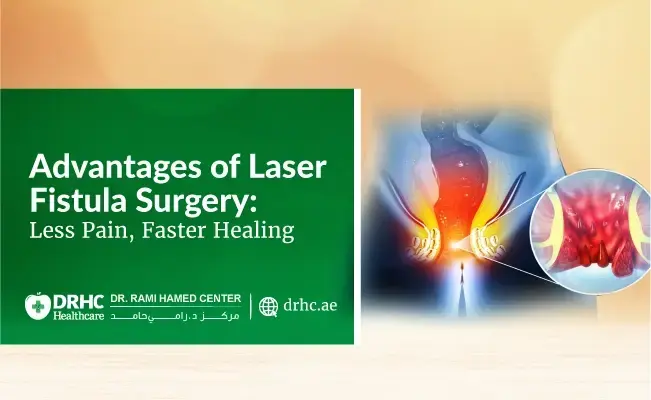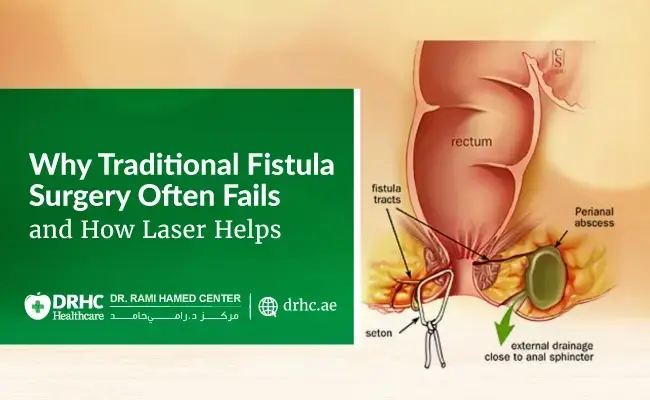
At Dr. Rami Hamed Center (DRHC Dubai), we are committed to providing advanced, minimally invasive solutions for treating anorectal conditions. One of the latest innovations in this field is FiLaC (Fistula Laser Closure) — a sphincter-preserving alternative to traditional fistula surgeries. In this article, we compare FiLaC with traditional surgical methods to help patients understand the benefits and differences of each approach.
What Is an Anal Fistula?
An anal fistula is an abnormal tunnel that forms between the anal canal and the skin near the anus, usually as a result of a previously untreated anal abscess. These fistulas can cause symptoms such as pain, swelling, pus drainage, and repeated infections. Surgery is typically required to close the fistula and prevent further complications.
Traditional Fistula Surgery: What It Involves
Traditional surgical options for anal fistulas include:
1. Fistulotomy
- Fistulectomy is a surgical procedure where a surgeon completely removes a fistula
- The entire fistula tract is surgically opened and left to heal from the inside out.
- Very effective for simple, low-lying fistulas.
- Often requires cutting through a portion of the anal sphincter.

2. Seton Placement
- A silk or rubber thread is placed through the fistula to help drain the infection and slowly cut through the tract over time.
- Typically used for complex or high fistulas.
3. Advancement Flap
- The internal opening of the fistula is covered with a flap of healthy rectal tissue.
- Used when preserving continence is critical.
Risks of Traditional Surgery
- Incontinence risk due to cutting of the sphincter muscle.
- Longer recovery time and wound care needs.
- Pain and discomfort during healing.
- Higher recurrence rate in some cases.
FiLaC (Fistula Laser Closure): A Modern, Gentle Alternative
FiLaC is a minimally invasive, sphincter-preserving laser technique for treating anal fistulas. It uses a radial laser probe that emits controlled thermal energy to ablate (seal) the fistula tract from within, promoting natural healing.
How FiLaC Works
- A radial-emitting laser fiber is inserted through the fistula tract.
- The laser delivers precise, circular energy as the fiber is withdrawn.
- This energy destroys the fistula lining and causes the tract to collapse and close.
- The anal sphincter remains intact throughout the procedure.
Comparing FiLaC with Traditional Fistula Surgery
Invasiveness and Pain
FiLaC is much less invasive than traditional surgery. While traditional procedures often involve cutting through tissues, FiLaC works internally through the tract, leading to minimal trauma and less postoperative pain.
Sphincter Preservation
Unlike fistulotomy or seton techniques that may involve cutting through the anal sphincter, FiLaC is designed to preserve the sphincter entirely, making it ideal for complex or high fistulas where continence must be maintained.
Recovery Time
Patients undergoing FiLaC typically experience faster recovery, minimal downtime, and a quicker return to normal activities. Traditional surgery often requires a longer healing period, with regular wound care and more follow-up visits.
Complications and Recurrence
FiLaC carries a lower risk of complications such as infection or incontinence. When properly selected and performed by experienced surgeons, FiLaC can also have a lower recurrence rate compared to conventional methods, especially in recurrent or complex cases.
Cosmetic and Lifestyle
FiLaC leaves no external scars or wounds and is usually performed as an outpatient procedure. Traditional surgery may leave visible scars and require more extensive post-op care.
Our Related Blogs:
- How VAAFT Reduces Recurrence in Complex Anal Fistulas
- What Makes VAAFT a Sphincter-Saving Procedure?
- Step-by-Step Guide: What to Expect During Laser FiLaC Fistula Surgery
Is FiLaC Right for You?o
FiLaC is suitable for a wide range of fistulas, including complex and recurrent cases. It is especially recommended for patients who want to avoid the risks associated with cutting the anal sphincter. A full evaluation at DRHC Dubai — including imaging studies such as MRI — will help determine whether FiLaC is the best treatment option for your condition.
Why Choose DRHC Dubai?
At Dr. Rami Hamed Center, our colorectal specialists are trained in advanced laser techniques and minimally invasive surgery. We prioritize patient safety, comfort, and long-term outcomes. With personalized care, modern technology, and expert surgeons, DRHC Dubai is a leading center for treating anal fistulas with FiLaC and other innovative methods.
Book Your Consultation Today
If you're dealing with the discomfort of an anal fistula, don’t wait. Let us help you find the best, least invasive treatment available.
📞 Call Us: +97142798200
📍 Visit Us: Dr Rami Hamed Center, Dubai HealthcareCity
🌐 Website: www.drhc.ae
Topic: Proctology General Surgery




.webp)


.webp)

Leave a comment